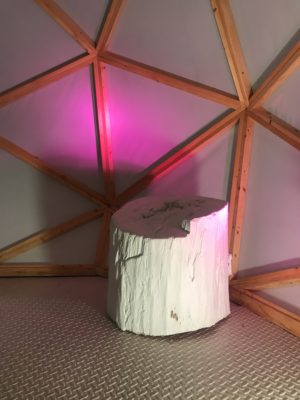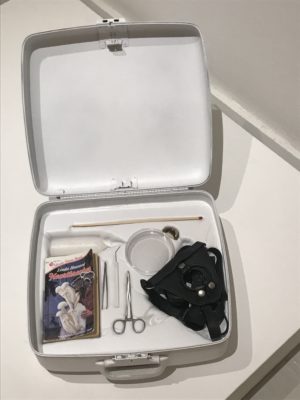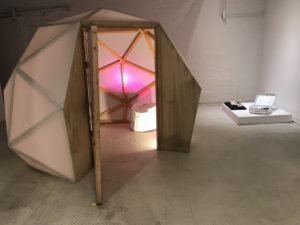Eli Brown: Museum of Queer Ecologies at Distillery Gallery
By: Emily Bass
In his exhibition Museum of Queer Ecologies at Distillery Gallery (on view through October 25), multidisciplinary artist Eli Brown connects conversations about nature and biology to discourses around queerness. Through a range of media—sound installation, video, sculpture and an illustrated zine—Brown builds a speculative, imagined futurist world (potentially not so far in the future) after sea levels have risen to unlivable levels. In this world, Brown examines our systems of classifying gender—that is, understanding sex and gender as concrete binary categories which are “biological” and “natural.” Instead, he sees “trans-ness as a lineage, and as an evolutionary phenomenon that is not always human.”
Brown points to nature as a multifaceted spectrum, asking the viewer to consider examples such as fungi to better understand sex and gender variance in humans. Fungi are an interesting example of life’s diversity: Some mushrooms have over 20,000 different genders, and fungal species can reproduce both sexually and asexually.
Museum of Queer Ecologies is based on queer ecological thought—the interdisciplinary practice of disrupting heterosexist understandings of sexuality and nature and reimagining the evolutionary process through a queer lens.

The all-white gallery space, graced with a hazy aura cast by one fluorescent pink light, is transformed into a sterile yet fantastical laboratory, where one can imagine a post-human entity being grown somewhere in a Petri dish. This unnatural shade of pink, which is a frequent symbol within queer liberation movements, sets the tone for the exhibition: unsettling, disruptive and radically queer.

Future Species Survival Kit, a briefcase complete with a candle and match, Petri dish, a leather harness and a queer romance novel collaged over with images of mushrooms, is a tongue-in-cheek post-apocalyptic survival kit. Beside it lay phallic-shaped objects, grown from living material such as flax substrate, fungal mycelium and schizophyllum commune species. When viewed together, the two pieces form a “never-before seen prototype for post-human love, a living dildo with reproductive capacities!” The assemblage pokes holes at the binaries that shape notions of evolutionary biology— biological/constructed, natural/unnatural and useful/useless—which are used to invalidate trans bodies. In Brown’s futurist world, hybrid bodies are anything but useless; their fluidity and adaptability are what allows a new species to grow in Earth’s disparate environment. When life on Earth comes to a halt, queerness still finds a way to create possibility.

Brown complements this imagined queer utopia, free from problematic notions of evolutionary biology, with the stories of trans and gender nonconforming people he has met in real-earth-life. In Greenhouse, an enclosed shelter, visitors are encouraged to sit and listen to the voices of three individuals of different generations speak about their transitions, identities and labels. The title Greenhouse alludes to the nature of gender identity: It grows and mutates over time as our understanding of, and language around, gender both develop. Hearing the voices of these individuals connects the otherworldly-ness of Museum of Queer Ecologies back to our current cultural climate. The questions Brown poses are framed in a future context, but queer ecology, LGBTQ+ rights and other liberation perspectives need to be considered today.

Museum of Queer Ecologies plops us into the aftermath of the apocalypse, forcing us to leave behind preconceived notions of the life we know on Earth. However, hope is not lost for our current society. As we’ve learned from mushrooms, life doesn’t fit into narrow boxes. Human and non-human experience alike are diverse and blessed with multiplicity.
